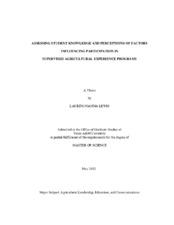| dc.contributor.advisor | Rayfield, John | |
| dc.creator | Lewis, Lauren Joanna | |
| dc.date.accessioned | 2012-07-16T15:58:22Z | |
| dc.date.accessioned | 2012-07-16T20:24:21Z | |
| dc.date.available | 2012-07-16T15:58:22Z | |
| dc.date.available | 2012-07-16T20:24:21Z | |
| dc.date.created | 2012-05 | |
| dc.date.issued | 2012-07-16 | |
| dc.date.submitted | May 2012 | |
| dc.identifier.uri | https://hdl.handle.net/1969.1/ETD-TAMU-2012-05-11028 | |
| dc.description.abstract | The purpose of this study was to assess student knowledge and perceptions of factors influencing participation in Supervised Agricultural Experience (SAE) programs. This descriptive study was conducted in 120 randomly selected agricultural education programs throughout four purposively selected states representative of the National FFA regions. Within each state the programs randomly selected to participate were from FFA divisions characterized as having urban city-centers with outlying rural/suburban areas. Students in Florida, Indiana, Missouri, and Utah completed a researcher-designed questionnaire assessing knowledge and perceptions on factors influencing SAE participation. A response rate of 43.3% (N = 120, n = 52) was achieved, with questionnaires completed by 1,038 students. According to findings of this study 45.6% (n = 473) of the students participated in SAE programs, with most categorized as an entrepreneurship SAE and classified as a livestock project. Students could only identify at most three of five SAE categories, and those without a SAE program were either not or somewhat familiar with the five SAE categories. Students surveyed in Missouri and Utah appeared to have the strongest SAE knowledge. Each state appeared to have three main types of school resources available for use by student SAE programs. Student perceptions indicated that teachers did encourage all students to have a SAE program and apply for awards and recognition; however, most did not receive awards and recognition for their SAE program. Students reported receiving SAE help from their teacher on a monthly basis most frequently. Most students used a paper-based SAE record book which they updated weekly or monthly. Students on average received a total of nine to 34 days of classroom SAE instruction and a total of eight to 33 days of classroom recordkeeping instruction during enrollment in agricultural education courses. Factors such as enjoyment of agricultural education courses, parental and teacher support and encouragement, resources (money and facilities), and opportunities for awards and recognition did not seem to influence student SAE participation. Contrary to previous research, involvement in community and school activities did not seem to negatively influence student SAE participation. Students did not believe they needed more SAE and recordkeeping instruction. | en |
| dc.format.mimetype | application/pdf | |
| dc.language.iso | en_US | |
| dc.subject | Supervised agricultural experience | en |
| dc.subject | SAE | en |
| dc.subject | agricultural education | en |
| dc.subject | student SAE projects | en |
| dc.subject | student SAE programs | en |
| dc.subject | experiential learning | en |
| dc.title | Assessing Student Knowledge and Perceptions of Factors Influencing Participation in Supervised Agricultural Experience Programs | en |
| dc.type | Thesis | en |
| thesis.degree.department | Agricultural Leadership, Education, and Communications | en |
| thesis.degree.discipline | Agricultural Leadership, Education, and Communications | en |
| thesis.degree.grantor | Texas A&M University | en |
| thesis.degree.name | Master of Science | en |
| thesis.degree.level | Masters | en |
| dc.contributor.committeeMember | Moore, Lori L. | |
| dc.contributor.committeeMember | Skaggs, Chris | |
| dc.type.genre | thesis | en |
| dc.type.material | text | en |


